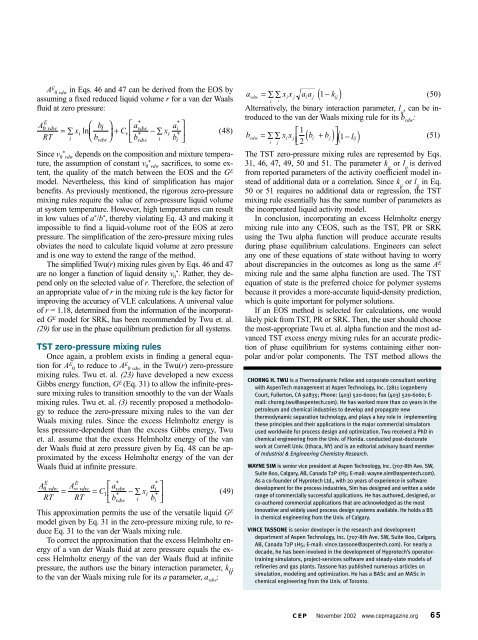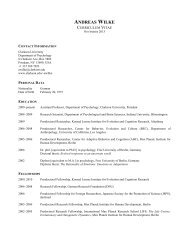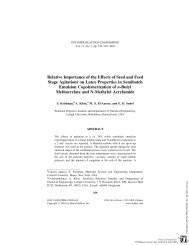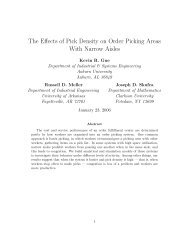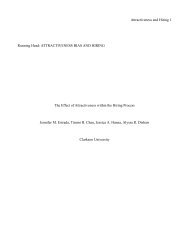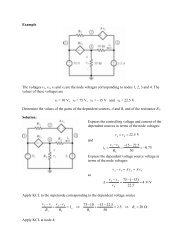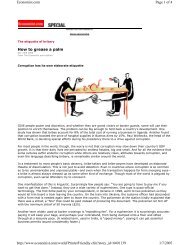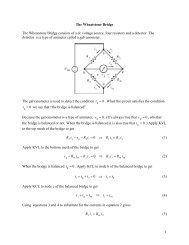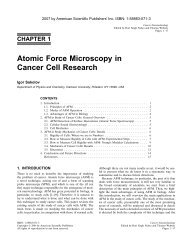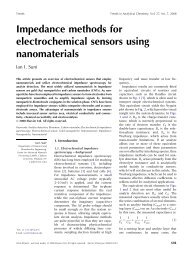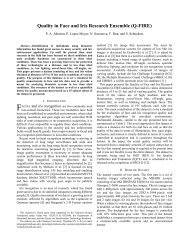Getting a Handle on Advanced Cubic Equations of State
Getting a Handle on Advanced Cubic Equations of State
Getting a Handle on Advanced Cubic Equations of State
You also want an ePaper? Increase the reach of your titles
YUMPU automatically turns print PDFs into web optimized ePapers that Google loves.
A E 0 vdw in Eqs. 46 and 47 can be derived from the EOS by<br />
assuming a fixed reduced liquid volume r for a van der Waals<br />
fluid at zero pressure:<br />
A<br />
RT<br />
bi<br />
x<br />
C<br />
b<br />
a<br />
x<br />
b<br />
a<br />
⎛ ⎞ ⎡ *<br />
* ⎤<br />
vdw<br />
i<br />
= ∑ i ln ⎜ ⎟ + r ⎢ * −∑i*<br />
⎥ ( )<br />
i ⎝ vdw ⎠ ⎣ vdw i bi<br />
⎦<br />
E<br />
0 vdw<br />
48<br />
Since v 0 * vdw depends <strong>on</strong> the compositi<strong>on</strong> and mixture temperature,<br />
the assumpti<strong>on</strong> <strong>of</strong> c<strong>on</strong>stant v 0 * vdw sacrifices, to some extent,<br />
the quality <strong>of</strong> the match between the EOS and the G E<br />
model. Nevertheless, this kind <strong>of</strong> simplificati<strong>on</strong> has major<br />
benefits. As previously menti<strong>on</strong>ed, the rigorous zero-pressure<br />
mixing rules require the value <strong>of</strong> zero-pressure liquid volume<br />
at system temperature. However, high temperatures can result<br />
in low values <strong>of</strong> a * /b * , thereby violating Eq. 43 and making it<br />
impossible to find a liquid-volume root <strong>of</strong> the EOS at zero<br />
pressure. The simplificati<strong>on</strong> <strong>of</strong> the zero-pressure mixing rules<br />
obviates the need to calculate liquid volume at zero pressure<br />
and is <strong>on</strong>e way to extend the range <strong>of</strong> the method.<br />
The simplified Twu(r) mixing rules given by Eqs. 46 and 47<br />
are no l<strong>on</strong>ger a functi<strong>on</strong> <strong>of</strong> liquid density v 0 *. Rather, they depend<br />
<strong>on</strong>ly <strong>on</strong> the selected value <strong>of</strong> r. Therefore, the selecti<strong>on</strong> <strong>of</strong><br />
an appropriate value <strong>of</strong> r in the mixing rule is the key factor for<br />
improving the accuracy <strong>of</strong> VLE calculati<strong>on</strong>s. A universal value<br />
<strong>of</strong> r = 1.18, determined from the informati<strong>on</strong> <strong>of</strong> the incorporated<br />
G E model for SRK, has been recommended by Twu et. al.<br />
(29) for use in the phase equilibrium predicti<strong>on</strong> for all systems.<br />
TST zero-pressure mixing rules<br />
Once again, a problem exists in finding a general equati<strong>on</strong><br />
for A E 0 to reduce to A E 0 vdw in the Twu(r) zero-pressure<br />
mixing rules. Twu et. al. (23) have developed a new excess<br />
Gibbs energy functi<strong>on</strong>, G E (Eq. 31) to allow the infinite-pressure<br />
mixing rules to transiti<strong>on</strong> smoothly to the van der Waals<br />
mixing rules. Twu et. al. (3) recently proposed a methodology<br />
to reduce the zero-pressure mixing rules to the van der<br />
Waals mixing rules. Since the excess Helmholtz energy is<br />
less pressure-dependent than the excess Gibbs energy, Twu<br />
et. al. assume that the excess Helmholtz energy <strong>of</strong> the van<br />
der Waals fluid at zero pressure given by Eq. 48 can be approximated<br />
by the excess Helmholtz energy <strong>of</strong> the van der<br />
Waals fluid at infinite pressure.<br />
This approximati<strong>on</strong> permits the use <strong>of</strong> the versatile liquid GE A A<br />
C<br />
RT RT<br />
model given by Eq. 31 in the zero-pressure mixing rule, to reduce<br />
Eq. 31 to the van der Waals mixing rule.<br />
To correct the approximati<strong>on</strong> that the excess Helmholtz energy<br />
<strong>of</strong> a van der Waals fluid at zero pressure equals the excess<br />
Helmholtz energy <strong>of</strong> the van der Waals fluid at infinite<br />
pressure, the authors use the binary interacti<strong>on</strong> parameter, kij to the van der Waals mixing rule for its a parameter, avdw :<br />
a<br />
x<br />
b<br />
a<br />
E E<br />
*<br />
0 vdw<br />
⎡<br />
* ⎤<br />
∞ vdw vdw<br />
i<br />
= = 1⎢<br />
* −∑i*<br />
⎥<br />
( 49)<br />
⎣ vdw i bi<br />
⎦<br />
a = ∑ ∑ x x aa 1 − k<br />
( 50)<br />
vdw i j<br />
i j<br />
( )<br />
i j ij<br />
Alternatively, the binary interacti<strong>on</strong> parameter, l ij , can be introduced<br />
to the van der Waals mixing rule for its b vdw :<br />
( )<br />
bvdw = x x<br />
⎡<br />
∑ ∑ i j b i + b<br />
⎤<br />
j lij<br />
i j ⎣⎢ ⎦⎥ −<br />
1<br />
( 1<br />
2<br />
)<br />
( 51)<br />
The TST zero-pressure mixing rules are represented by Eqs.<br />
31, 46, 47, 49, 50 and 51. The parameter k ij or l ij is derived<br />
from reported parameters <strong>of</strong> the activity coefficient model instead<br />
<strong>of</strong> additi<strong>on</strong>al data or a correlati<strong>on</strong>. Since k ij or l ij in Eq.<br />
50 or 51 requires no additi<strong>on</strong>al data or regressi<strong>on</strong>, the TST<br />
mixing rule essentially has the same number <strong>of</strong> parameters as<br />
the incorporated liquid activity model.<br />
In c<strong>on</strong>clusi<strong>on</strong>, incorporating an excess Helmholtz energy<br />
mixing rule into any CEOS, such as the TST, PR or SRK<br />
using the Twu alpha functi<strong>on</strong> will produce accurate results<br />
during phase equilibrium calculati<strong>on</strong>s. Engineers can select<br />
any <strong>on</strong>e <strong>of</strong> these equati<strong>on</strong>s <strong>of</strong> state without having to worry<br />
about discrepancies in the outcomes as l<strong>on</strong>g as the same A E<br />
mixing rule and the same alpha functi<strong>on</strong> are used. The TST<br />
equati<strong>on</strong> <strong>of</strong> state is the preferred choice for polymer systems<br />
because it provides a more-accurate liquid-density predicti<strong>on</strong>,<br />
which is quite important for polymer soluti<strong>on</strong>s.<br />
If an EOS method is selected for calculati<strong>on</strong>s, <strong>on</strong>e would<br />
likely pick from TST, PR or SRK. Then, the user should choose<br />
the most-appropriate Twu et. al. alpha functi<strong>on</strong> and the most advanced<br />
TST excess energy mixing rules for an accurate predicti<strong>on</strong><br />
<strong>of</strong> phase equilibrium for systems c<strong>on</strong>taining either n<strong>on</strong>polar<br />
and/or polar comp<strong>on</strong>ents. The TST method allows the<br />
CHORNG H. TWU is a Thermodynamic Fellow and corporate c<strong>on</strong>sultant working<br />
with AspenTech management at Aspen Technology, Inc. (2811 Loganberry<br />
Court, Fullert<strong>on</strong>, CA 92835; Ph<strong>on</strong>e: (403) 520-6000; Fax (403) 520-6060; Email:<br />
chorng.twu@aspentech.com). He has worked more than 20 years in the<br />
petroleum and chemical industries to develop and propagate new<br />
thermodynamic separati<strong>on</strong> technology, and plays a key role in implementing<br />
these principles and their applicati<strong>on</strong>s in the major commercial simulators<br />
used worldwide for process design and optimizati<strong>on</strong>. Twu received a PhD in<br />
chemical engineering from the Univ. <strong>of</strong> Florida. c<strong>on</strong>ducted post-doctorate<br />
work at Cornell Univ. (Ithaca, NY) and is an editorial advisory board member<br />
<strong>of</strong> Industrial & Engineering Chemistry Research.<br />
WAYNE SIM is senior vice president at Aspen Technology, Inc. (707-8th Ave. SW,<br />
Suite 800, Calgary, AB, Canada T2P 1H5; E-mail: wayne.sim@aspentech.com).<br />
As a co-founder <strong>of</strong> Hyprotech Ltd., with 20 years <strong>of</strong> experience in s<strong>of</strong>tware<br />
development for the process industries, Sim has designed and written a wide<br />
range <strong>of</strong> commercially successful applicati<strong>on</strong>s. He has authored, designed, or<br />
co-authored commercial applicati<strong>on</strong>s that are acknowledged as the most<br />
innovative and widely used process design systems available. He holds a BS<br />
in chemical engineering from the Univ. <strong>of</strong> Calgary.<br />
VINCE TASSONE is senior developer in the research and development<br />
department <strong>of</strong> Aspen Technology, Inc. (707-8th Ave. SW, Suite 800, Calgary,<br />
AB, Canada T2P 1H5; E-mail: vince.tass<strong>on</strong>e@aspentech.com). For nearly a<br />
decade, he has been involved in the development <strong>of</strong> Hyprotech’s operatortraining<br />
simulators, project-services s<strong>of</strong>tware and steady-state models <strong>of</strong><br />
refineries and gas plants. Tass<strong>on</strong>e has published numerous articles <strong>on</strong><br />
simulati<strong>on</strong>, modeling and optimizati<strong>on</strong>. He has a BASc and an MASc in<br />
chemical engineering from the Univ. <strong>of</strong> Tor<strong>on</strong>to.<br />
CEP November 2002 www.cepmagazine.org 65


